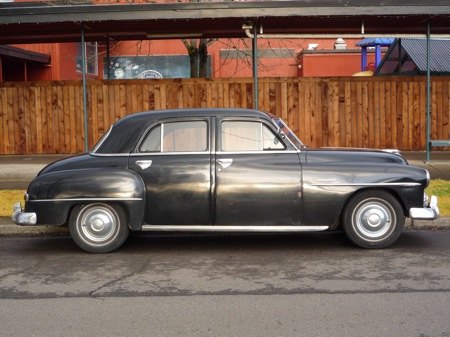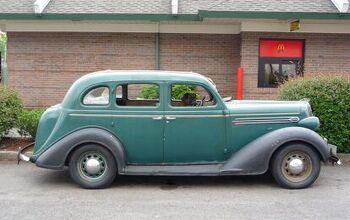Curbside Classics: 1951 Plymouth

This is the very car that inspired “Curbside Classics.” I’ve been admiring its blocky solidity for ten years, whenever its owner and I happen to workout at the Y simultaneously. I can count on its reassuring, unchanging presence at least a couple of times a month (an anchor of constancy in this turbulent world). And you can’t get much more anchor-like than this cast-iron 1951 Plymouth Cranbrook. But anchors sink, and this car began Plymouth’s long dive into the deep blue.
Chrysler products of this vintage developed a rep early on for their build quality. But the Plymouth wasn’t just solid; it was also stolid. And that’s not what folks were looking for in 1951 (or pretty much anytime). After almost a full decade with few new models, Americans after WWII were more than ready for a little excitement. They wanted sleek, and low. Ford and GM delivered; Chrysler . . . not so much.
Ironic too, since Chrysler’s meteoric rise in the twenties was in good part to their handsome looks. And when Chrysler boldly launched the attractive low-price Plymouth brand in 1928, it was an instant hit. Within three years, Plymouth captured the number three sales spot behind Chevrolet and Ford. That was no mean feat considering the dozens of brands competing back then—think China 2009.
And Plymouth stayed a solid number three for over twenty years. But after Walter Chrysler died in 1940, the baton was handed to K.T. Keller. Chrysler styling now . . . wasn’t. “Cars should accommodate people rather than the far-out ideas of designers,” Keller said. Was he referring to Harley Earl and his GM Motorama dream-mobiles? The fedora-wearing Chrysler prez dictated that the all-new ’49 Chrysler products accommodate hat wearers, with room to spare: “the styling won’t knock your hat off, but neither will getting in one of our cars.”
The result is self evident. Abe Lincoln in his stovepipe hat would feel at ease in this tall-boy. Well, the stovepipe-hat-wearing market was small, if non-existent. But the market for anything new was huge. Americans’ pent-up appetite for new wheels in 1949 created the biggest seller’s market ever. And the stodgy un-Dodge sold well enough.
That is, until the market caught up. In 1951, Plymouth moved 600,000 fedora-mobiles. But the unchanged 1952 model crashed, down by a third. And by 1954, Plymouth tumbled out of the bronze. There was a brief return after 1957 with the dramatic Virgil Exner-styled “Suddenly it’s 1960” models. But after two more cameo appearances in 1971 and 1974, Plymouth’s days on the low rung of the winner’s podium was over.
Plymouth had developed a reputation for dullness and styling stodginess (or quirkiness in some years, like 1962) that it could never quite shake, despite some good efforts along the way. A rep it took all the way to its grave.
But this original Cranbrook is far from its final resting place. At the rate it’s aging, it’s got another sixty years in it easy—before it needs a restoration. And, ironically enough, its proportions actually look more contemporary today than they did in the low-slung sixties. Tall boxy cars and crossovers are in, the benefits in seating comfort rediscovered. Keller was ahead of his time. Didn’t I read somewhere that fedoras are in again, too?
Sitting in one of these old tanks is a joy. Driving one . . . well, you have to change hat and mindset to 1951. Or even 1933. That’s the year the Plymouth’s 218 cubic inch flathead six first saw the light of day. These long-stroke (4.38″) chuffers deliver a gentle but steady dose of torque, right from idle speed (max. 175 lb·ft @ 1200 rpm—I wasn’t exaggerating). Just the ticket for chugging around town and not sweating the not-fully-synchronized three-speed tranny.
On the highway, these gentle whales are happiest at a pre-interstate system 55 or 60 mph. The advertised horsepower was 97 gross @ 3600 rpm—maybe 85 horses in today’s net rating. That might take you up to an equivalent number of miles an hour. But you wouldn’t want to. Everything wants to happen slowly, like the unassisted steering, and gently, like the brakes. And the word “handling” hadn’t entered Detroit’s dictionary yet.
This car brings back a raft of memories. They were ubiquitous in Iowa back in the early sixties. Ironically, I hated them then for their durability. They were a blot on the carscape, which in my mind should have consisted of nothing but dazzling 1960 Pontiac Star Chiefs and the like.
But on one of my hitchhikes, in 1974, I got a ride in one of these, right through a blizzard. Everyone else was stuck or off the road. The already elderly Plymouth didn’t have enough power to spin its wheels and just chugged on through. Right into a special place in my heart.

More by Paul Niedermeyer
Latest Car Reviews
Read moreLatest Product Reviews
Read moreRecent Comments
- Justin You guys still looking for that sportbak? I just saw one on the Facebook marketplace in Arizona
- 28-Cars-Later I cannot remember what happens now, but there are whiteblocks in this period which develop a "tick" like sound which indicates they are toast (maybe head gasket?). Ten or so years ago I looked at an '03 or '04 S60 (I forget why) and I brought my Volvo indy along to tell me if it was worth my time - it ticked and that's when I learned this. This XC90 is probably worth about $300 as it sits, not kidding, and it will cost you conservatively $2500 for an engine swap (all the ones I see on car-part.com have north of 130K miles starting at $1,100 and that's not including freight to a shop, shop labor, other internals to do such as timing belt while engine out etc).
- 28-Cars-Later Ford reported it lost $132,000 for each of its 10,000 electric vehicles sold in the first quarter of 2024, according to CNN. The sales were down 20 percent from the first quarter of 2023 and would “drag down earnings for the company overall.”The losses include “hundreds of millions being spent on research and development of the next generation of EVs for Ford. Those investments are years away from paying off.” [if they ever are recouped] Ford is the only major carmaker breaking out EV numbers by themselves. But other marques likely suffer similar losses. https://www.zerohedge.com/political/fords-120000-loss-vehicle-shows-california-ev-goals-are-impossible Given these facts, how did Tesla ever produce anything in volume let alone profit?
- AZFelix Let's forego all of this dilly-dallying with autonomous cars and cut right to the chase and the only real solution.
- Zelgadis Elantra NLine in Lava Orange. I will never buy a dirty dishwater car again. I need color in my life.







































Comments
Join the conversation
I just wanted to add something to your wonderful write up on these cars. I have personally owned 3 of these, one was a '51 like the one in your photos and 2 '52s. I guess you would have to restore a '51 to know this and I find it really funny how many of these cars I have seen in pictures that have the front hood emblem upside down. I didn't know mine was until I came across a New Old Stock center piece, which is the plastic insert. Over time these inserts fade so badly that the symbols are no longer legible, so when the car gets a paint job the whole emblem is installed the way it looks like it should go, upside down. An interesting note is that the new insert has in it an Indian in a head dress offering a sheave of grain to the new arrivals of the Plymouth ship from England.
I owned a 1941 Special Deluxe Plymouth and a 1951 Plymouth Cranbrook. Apparently the 41 had seen much use during WWII when new cars were not being built. The engine had piston slap which led to piston ring failure. When I disassembled the engine the rings came out in pieces. After many miles, the 51 engine failed in the same manner. Piston slap and engine oil blowby. The bottom of the car was covered by oil. Another common problem was the transmission falling out of third gear while coasting. I had a MOPAR rebuilt engine installed in the 51 and drove it quite a few more miles before selling it and buying a new 1959 Volvo P544.